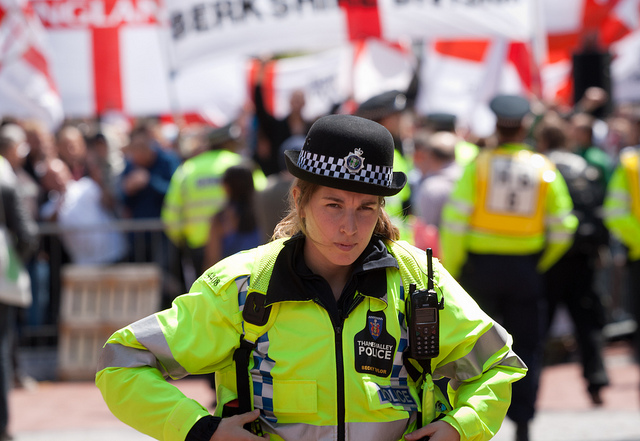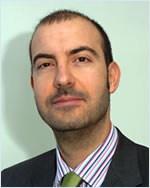The English Defence League’s ‘rational Islamophobia’ is a racist discourse, but it is not confined to the EDL
The emergence of the English Defence League in 2009 led to renewed discussion of the extent and nature of Islamophobia in British society. George Kassimeris and Leonie Jackson have studied the discourse and ideology of the EDL based on the organisation’s public statements. They find that the ‘rational Islamophobia’ espoused by the EDL does constitute racism, but of a socially acceptable form that is also common among the media, politicians and intellectuals.

Police officers maintaining order at an English Defence League rally in 2011. Credit: hertzsprung (CC BY-NC-SA 2.0)
The English Defence League (EDL) emerged in 2009 as a mass street protest movement against ‘Islamic extremism’. From the movement’s early days there has been a tension between the violence and intimidation of protests and the apparently liberal aims espoused by the leadership on the group’s website englishdefenceleague.org. The EDL have claimed from the start that they are ‘not racist, not violent, just no longer silent’, and explained regularly reported racist chanting at protests as the work of unaffiliated far-right elements intent on derailing the movement’s legitimate aims. These claims have been rejected by opponents of the group, such as Unite Against Fascism (UAF) who assert that the EDL is merely another ‘march and grow’ far-right outfit, aiming to capitalise on the vacuum created by the British National Party’s (BNP) loss of influence.
While it is important not to take EDL claims at face value, dismissing the group as simply racist fails to take into account crucial elements that construct EDL identity as anti-racist. Commitment to multicultural diversity is regularly expressed on the EDL’s website, through slogans such as ‘black and white unite’, and through the existence of specialist sub-groups (including Jewish, Sikh, and LGBT divisions). In October 2013, leader Tommy Robinson left the EDL, claiming he was spending too much time attempting to keep white supremacists away from EDL demonstrations.
There are significant differences between the EDL and far-right groups such as the BNP. While both focus on Islam as a central danger to Britain, the latter views Muslims as a particular symptom of the wider problem of immigration and multiculturalism. The EDL, by contrast, is not concerned with non-Muslim minorities, and their successful integration is considered proof of just how problematic Muslims are. Additionally, although high profile EDL figures have had past BNP connections (including Robinson), it is a disciplinary offence for any BNP member to attend EDL events, while the rejection of BNP advances is considered a point of pride for the EDL.
The overwhelming concentration on the attitudes of supporters has further confused the issue, and a better understanding of how the group’s ‘rational Islamophobia’ functions may be gleaned from its official ideological position, presented on the EDL News section of its website. Here a range of rhetorical strategies serve to racialise Muslims, while simultaneously positioning writers within the boundaries of acceptable discourse. This can best be understood as (culturally) racist discourse construction.
Racist discourse construction involves the creation of an in-group and an out-group, where the in-group claims the right to decide who can belong and the out-group is represented as threatening its privileges and position. By consistently representing Muslims as uniquely problematic, explaining this behaviour as a product of ‘Islamic ideology’, and demanding total reform of the religion, EDL News discourse made liberal use of this binary, racialising Muslim culture as the source of Muslim behaviour and conferring the role of arbiters of acceptability to culturally superior non-Muslims.
Racist discourse also employs rhetorical strategies that serve to present actors as within the bounds of acceptable talk, and in EDL News strategies such as projection, denials and positive-self/negative-other representations were abundant. The EDL projected a culturally racist motivation on to Muslims, claiming they were in the grip of a racist ideology of ‘Islamic supremacism’. Mosques were therefore viewed as symbolic of a Muslim desire to dominate, while increasingly available halal meat was cited as evidence of the ‘creeping Islamification’ of Britain. This fed into a narrative of non-Muslim victimhood in which EDL protest was constructed as a counter mobilisation against unequal treatment. Through denials, the EDL dismissed Muslim complaints of Islamophobia as ‘playing the race card’; nothing more than the paranoid fantasies of those who should be addressing ‘Islamic extremism’ rather than complaining about discrimination. Finally, positive-self and negative-other representations served to present the successful integration of non-Muslim minority groups as an account of British tolerance and hospitality, while at the same time showing that Muslims were making unacceptable demands that exceeded British cultural tolerance. The EDL’s preoccupation with Muslims was thus presented as a natural reaction to their negative behaviour, within a victim blaming discourse that held Muslims responsible for anti-Muslim sentiment.
Such strategies are typical of racist discourse, and serve to position speakers and writers within the boundaries of acceptable talk about minorities, allowing them to be racist without sounding racist. Through such strategies a dichotomy is created between the in-group (British non-Muslims) and the out-group (Muslims), allowing the former to position itself as entitled to decide whether the latter has transgressed the boundaries of social acceptability. EDL discourse on Muslims worked on one hand to preserve traditional ethno-cultural dominance and privilege and on the other to contain challenges to this dominance, believed to stem primarily from Muslims.
It is not sufficient to conceptualise the EDL as simply racist. The movement is not merely another manifestation of the far-right, but a single issue group that specifically targets Muslims as a problematic and dangerous out-group in Britain. Yet this ‘rational Islamophobia’ is not particular to the EDL. Similar views are presented every day in newspapers, by government ministers and by think-tank intellectuals who all converge around the theme that Muslims in Britain are problematic. Petitions by opponents to have the group proscribed as extremist have failed precisely because it is not particularly ‘extreme’ to articulate such views.
EDL News consistently asserts that the group is a symptom, and if there were no ‘Islamic extremism’ there would be no need for the EDL. Understanding the rhetorical strategies used by the group helps us to understand the way that Islamophobia functions as racist discourse, but it should also alert us to a broader problem. The EDL are indeed a symptom. Not, as they claim, of ‘Islamic extremism’, but of the increasingly socially acceptable discourse of ‘problematic Muslims’. The challenge posed by the group is therefore not simply to quell its violence or confront the more caustic elements of its protests. Rather, it requires deep reflection and confrontation of the entrenched societal Islamophobia that makes such a movement possible.
—
Note: This post represents the views of the authors, and does not give the position of Democratic Audit or the LSE. Please read our comments policy before commenting. Shortlink for this post: buff.ly/1kO4enE
—
 |
 |
George Kassimeris is Reader in Terrorism Studies at the University of Wolverhampton. Leonie Jackson is a PhD student at the University of Wolverhampton. A longer version of this post is forthcoming in the British Journal of Politics and International Relations. |





 Democratic Audit's core funding is provided by the Joseph Rowntree Charitable Trust. Additional funding is provided by the London School of Economics.
Democratic Audit's core funding is provided by the Joseph Rowntree Charitable Trust. Additional funding is provided by the London School of Economics.
Ministers, the media and intellectuals share the same form as Islamophobia as the EDL to some extent https://t.co/LHmrIRDU7g
The English Defence League’s ‘rational Islamophobia’ is a racist discourse, but it is not confined to the EDL https://t.co/EkHpfEw56M
The EDL constructs its own identity as anti-racist… is it? New post from George Kassimeris and Leonie Jackson today https://t.co/VcvZ9IlRaW
The English Defence League’s ‘rational Islamophobia’ is a racist discourse, that is not confined to the EDL alone. https://t.co/AHgw3nfzD3
The English Defence League’s ‘rational Islamophobia’ is a racist discourse, but it is not confined to the EDL https://t.co/lIEMrDwwWM